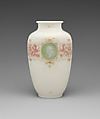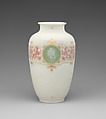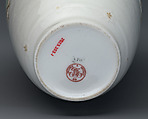Vase with Medallions of the Fates
Designer Albert-Ernest Carrier-Belleuse French
Taxile Maximin Doat French
Manufacturer Sèvres Manufactory French
Not on view
During Taxile Doat’s long career as a decorator at Sèvres manufactory from 1877–1905, he helped to develop pâte-sur-pâte, a decoration technique that entailed building thin layers of white slip atop a colored ground to achieve a cameo-like effect. First established by his teacher Marc Louis Solon, the technique was notoriously difficult to perfect. Though Doat later went on to make more organic forms of art pottery inspired by nature at his private studio located near Sèvres manufactory, this work demonstrates his command of classically inspired forms of decoration. Here, the profile images of Lachesis, Atropos, and Clotho, the Moirai, or Three Fates of Greek mythology, are set into a delicately incised vase shape designed by the sculptor Albert-Ernest Carrier-Belleuse, who also worked at the renowned porcelain manufactory.
This image cannot be enlarged, viewed at full screen, or downloaded.
This artwork is meant to be viewed from right to left. Scroll left to view more.






